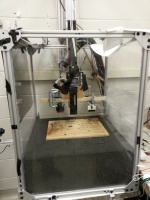Group 4 2014
Jumping on an Aerated Granular Medium
Group Members: Alex Lind, Cristian Salgueiro, Casey Trimble
Introduction

Granular media are unique in that they can easily transition from solid-like behavior to fluid behavior in response to external conditions. This creates an interesting environment for locomotion in a granular medium, which is a process that utilizes the transfer of force between the locomotive body and the medium. The transition from solid behavior to fluid behavior, or vice versa, can have a large effect on how efficient a method of propulsion is. One way to investigate the nature of force transfer in granular media is to manipulate the parametric constraints that govern the boundary between solid and fluid.
Aerating a granular medium by introducing an air flow from below is one way to accomplish this. By controlling the air flow, it is possible to reduce the amount of force required to reach the fluid regime in the medium. This transition may not be a linear function of air flow, and it is possible that insight could be gained from experiments that test the efficiency of a jumping robot on the medium as the flow rate is increased.
Theory and Previous Work
Interaction of a foot with granular media can be most simply modeled with the following equation: \begin{equation} \label{eq:motion} m_f\ddot{x}_f = F_{spring} + F_{GM} - m_fg \end{equation} where the force from the granular media is most simply modeled with the equation: \begin{equation}\label{eq:response} F_{GM} = k(\text{foot depth}) + \alpha(\text{foot speed})^2 \end{equation}
The mechanics of granular media have been studied in the past by the Complex Rheology and Biomechanics (CRAB) Lab at Georgia Tech. Some of the significant results obtained by this group include the study of two modes of jumping (a single jump and a delayed "stutter jump") on a granular media, which involved studying a more complex modeling equation for the medium.
Apparatus
To investigate the dynamics of a jumper with a variable stiffness spring... to be continued very soon.
Methods
Initially, the jumping robot was configured with a variable stiffness spring on hard ground. The robot was programmed to hop several times on the hard ground at a given frequency, forcing amplitude, and spring stiffness. These three parameters were varied systematically by an automated program in LabView.
A container filled with a granular medium (poppy seeds) will be aerated using a blower attached to the bottom through an air duct manifold that distributes an approximately uniform airflow. The flow rate will be controlled externally. Mounted on the surface will be a robot jumper that will be attached to a vertical sliding rod. The appendage of the jumper will be a spring of known spring constant, and the forcing of the jumper will be controlled externally. In later experiments, a controlled variable stiffness spring may be used to further expand the parameter space of the experiments.